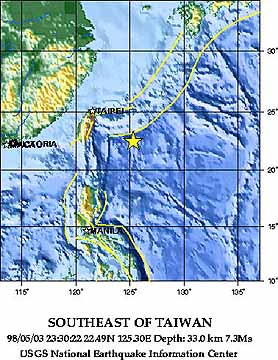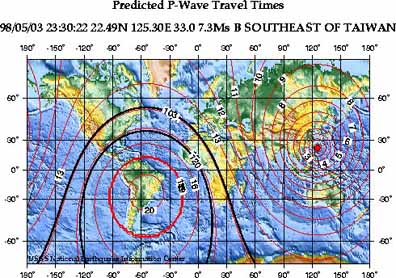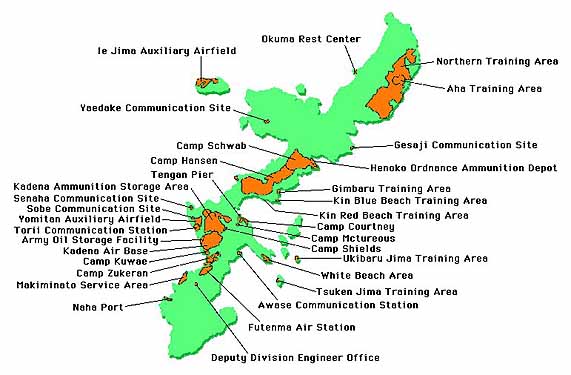|
|
|
|
|
|
|
. |
|
|
|
|
|
|
|
|
|
|
|
. |
|
|
|
|
One of the greatest discoveries in the history of archaeology was made last summer, off Japan There, spread over an amazing 311 miles on the ocean floor, are the well-preserved remains of an ancient city. Or at the very least, a number of closely related sites.
In the waters around Okinawa and beyond to the small island of Yonaguni, divers located eight separate locations beginning in March 1995. That first sighting was equivocal - a provocative, squared structure, so encrusted with coral that its manmade identity was uncertain. Then, as recently as the summer of 1996, a sports diver accidentally discovered a huge, angular platform about 40 feet below the surface, off the southwestern shore of Okinawa. The feature’s artificial provenance was beyond question. Widening their search, teams of more divers found another, different monument nearby. Then another, and another. They beheld long streets, grand boulevards, majestic staircases, magnificent archways, enormous blocks of perfectly cut and fitted stone - all harmoniously welded together in a linear architecture unlike anything they had ever seen before.
In the following weeks and months, Japan’s archaeological community joined the feeding-frenzy of discovery. Trained professionals formed a healthy alliance with the enthusiasts who first made the find. In a progressive spirit of mutual respect an working alliance, academics and amateurs joined forces to set an example of cooperation for the rest of the world. Their common cause soon bore rich fruit. In september, not far from the shore of the island of Yonaguni, more then 300 airline miles south from Okinawa, they found a gigantic, pyramidal structure in 100 feet of water. In what appeared to be a ceremonial center of broad promenades and flanking pylons, the gargantuan building measures 240 feet long.
Exceptionally clear sub-surface clarity, with 100 foot visibility a common factor, allowed for thorough photographic documentation, both still photography and video. These images provided the basis of japan’s leading headlines for more than a year. Yet, not a word about the Okinawa discovery reached the US public, until the magazine, “Ancient American” broke the news last spring. Since that scoop, only the CNN network televised a report about Japan’s underwater city. Nothing about it has been mentioned in any of the nation’s other archaeology publications, not even in any of our daily newspapers. One would imagine that such a mind-boggling find would be the most exciting piece of news an archaeologist could possibly hope to learn. Even so, outside of the “Ancient American” and CNN’s single report, the pall of silence covering all the facts about Okinawa’s structures screens them from view more effectively then their location at the bottom of the sea. Why? How can this appalling neglect persist in the face of a discovery of such unparalleled magnitude? At the risk of accusations of paranoia, one might conclude that a real conspiracy of managed information dominates America’s well-springs of public knowledge.
Frank Joseph - “Ancient American”
.
Divers Find World's Oldest Building
by Trushar Barot
A STRUCTURE thought to be the world's oldest building, nearly twice the age of the great pyramids of Egypt, has been discovered. The rectangular stone ziggurat under the sea off the coast of Japan could be the first evidence of a previously unknown Stone Age civilisation, say archeologists.
The monument is 600ft wide and 90ft high and has been dated to at least 8000BC. The oldest pyramid in Egypt, the Step Pyramid at Saqqara, was constructed more than 5,000 years later.
The structure off Yonaguni, a small island southwest of Okinawa, was first discovered 75ft underwater by scuba divers 10 years ago and locals believed it was a natural phenomenon.
Professor Masaki Kimura, a geologist at Ryukyu University in Okinawa, was the first scientist to investigate the site and has concluded that the mysterious five-layer structure was man-made. "The object has not been manufactured by nature. If that had been the case, one would expect debris from erosion to have collected around the site, but there are no rock fragments there," he said.
The discovery of what appears to be a road surrounding the building was further evidence that the structure was made by humans, he added.
Robert Schoch, professor of geology at Boston University, dived at the site last month. "It basically looks like a series of huge steps, each about a metre high. Essentially, it's a cliff face like the side of a stepped pyramid. It's a very interesting structure," he said. "It's possible that natural water erosion combined with the process of cracked rocks splitting created such a structure, but I haven't come across such processes creating a structure as sharp as this."
Further evidence that the structure is the work of humans came with the discovery of smaller underwater stone mounds nearby. Like the main building, these mini-ziggurats are made of stepped slabs and are about 10m wide and 2m high.
Kimura said it was too early to know who built the monument or its purpose. "The structure could be an ancient religious shrine, possibly celebrating an ancient deity resembling the god Nirai-Kanai, whom locals say gave happiness to the people of Okinawa from beyond the sea. This could be evidence of a new culture as there are no records of a people intelligent enough to have built such a monument 10,000 years ago," he said.
"This could only have been done by a people with a high degree of technology, probably coming from the Asian continent, where the oldest civilisations originate. There would have to have been some sort of machinery involved to have created such a huge structure."
Teruaki Ishii, professor of geology at Tokyo University, said the structure dated back to at least 8000BC when the land on which it was constructed was submerged at the end of the last ice age. "I hope this site is artificial as it would be very exciting. But at this time I feel it is too early to say. I think the structure could be natural, but part of it may have been made," he said.
The first signs of civilisation in Japan are traced to the Neolithic period around 9000BC. The people at this time lived as hunters and food- gatherers. There is nothing in the archeological record to suggest the presence of a culture advanced enough to have built a structure like the ziggurat.
British archeologists are, however, cautiously enthusiastic about the discovery which will be featured this summer in a Channel 4 documentary.
Jim Mower, an archeologist at University College London, said: "If it is confirmed that the site is as old as 10,000 years and is man-made, then this is going to change an awful lot of the previous thinking on southeast Asian history. It would put the people who made the monument on a par with the ancient civilisation of Mesopotamia and the Indus Valley."
![]()
...
![]()
Magnitude 7.7 quake hits Okinawa, causes minor tsunamis
Yonaguni Island nearest to underwater pyramids at: 123 E 24.30 N
Quake: 125 E 22.40N
Kyodo News Service
TOKYO, May 4 (Kyodo) - An earthquake of an estimated magnitude 7.7 on the open-ended Richter scale jolted Okinawa Prefecture, southwestern Japan, on Monday morning, causing some tsunamis along the coasts of the island prefecture, the Meteorological Agency said.
A number of tourists were visiting the subtropical islands for the Golden Week holidays, but police and coast guard have not received reports of casualties or damage from the temblor or tidal waves.
The agency lifted a tsunami or tidal wave warning at 11:15 a.m., two and a half hours after it was issued along the coasts of the islands affected by the quake, as well as along the coasts of Osaka and Wakayama prefectures in western Japan and those of Kyushu and Shikoku -- two of Japan's four main islands.
The quake occurred around 8:30 a.m. and registered 3 on the Japanese intensity scale of 7 on Iriomotejima, Ishigakijima, Taramajima, Yonagunijima and Miyakojima islands, according to the agency.
Its focus was in the Pacific, about 20 kilometers below the seabed about 260 km southeast of Ishigakijima, the agency said.
''I initially thought it was a fire'' because the alarm system was activated after the quake jolted the region, said Takaharu Shimoji, a hotel employee in Miyakojima Island said.
Kenyu Kawamitsu, a local fishery cooperative employee, said the quake lasted about two minutes.
After 9 a.m., a tidal wave less than 10 centimeters high reached Ishigakijima and tsunamis of several cm arrived in Yonagunijima and Miyakojima and the Okinawa prefectural capital of Naha, the agency said.
One plate in the earth's crust has been subducting another at this location, causing major quakes, said Megumi Mizoue, professor emeritus of seismology at the University of Tokyo.
Separately, a series of moderate quakes hit the Izu Peninsula, southwest of Tokyo, in the morning.
Ten quakes that could be felt, measuring an estimated 2.7 to 4.0 on the Richter scale, occurred between 6:39 a.m. and 8:16 a.m. Their focuses were some 10 km or less below the seabed off the east coast of the peninsula, the agency said.
The largest of the quakes took place around 6:44 a.m., measuring 3 on the Japanese scale in Ito, Shizuoka Prefecture, the agency said.
Many more temblors that could not be felt occurred on the peninsula -- more than 120 between 7 a.m. and 8 a.m. and 13 between 8 a.m. and 2 p.m.
The peninsula, dotted with hot spring resorts, has been hit by a new series of earthquakes since April 20. It experienced a number of fairly strong quakes in March last year.
AP-NY-05-04-98 0044EDT



![]()